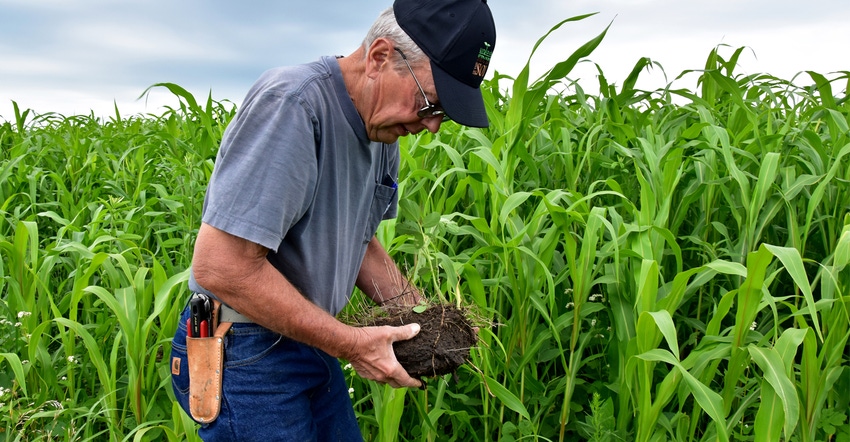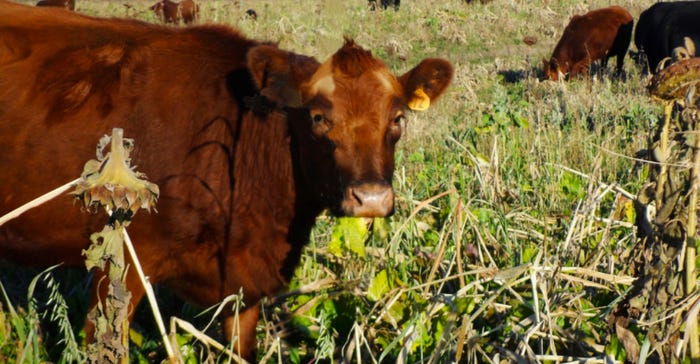November 25, 2020

If you’re no-tilling corn and soybeans and using a cereal rye cover crop, you’ve taken important first steps in improving your soil’s health. But if you really want to put the pedal to the metal to regenerate soil more quickly, consider adding three more components. That’s what veteran cover cropper and conservationist Paul Ackley started doing 10 years ago.
His system checks off all five key markers for regenerating and building healthy soil, instead of allowing soil to erode and degrade. He uses no-till, cover crops, a small grain crop (wheat) in the crop rotation, and livestock grazing cover crops. He also uses permanent conservation practices — terraces, grass waterways, wetlands, ponds, etc.
Related: Faster fix for poor soils and 'All I needed to know'
Ackley, a soil and water conservation district commissioner in Taylor County in southwest Iowa, has no-tilled since the 1980s. “I thought no-till would be a cure-all when I switched from tillage, but after six or seven years I was disappointed,” he says. While he had cut soil losses with no-till, he was still losing soil. That led him to add cover crops, wheat and livestock for grazing the cover crops.
No tolerable soil loss
“The term ‘tolerable soil loss’ makes no sense to me. They say a 5-ton per-acre per-year soil loss — considered tolerable by some people, even conservationists — is the thickness of a dime. Well, you won’t lose all your topsoil at that rate in the next year or two, but you will lose it gradually,” Ackley says. “We don’t have to accept that soil loss. My wife goes over our bank records, and when she sees an unexplained withdrawal, she wants to know right away what it is, and wants it fixed. That’s how I look at soil erosion; it’s an unexplained withdrawal of our soil account that needs to be fixed.”
He traces his long-standing commitment to conservation to when he was a boy. “I always wanted to farm,” Ackley says. “I remember seeing farm sales listed in the paper and watched farmers who were successful and those who had to quit. It seemed to me the farmers who were making a decent living always took care of their land.”
Ackley remembers his father seeding down most of his hills, and a neighbor he worked for, Guy Weir, making sure hay and oats were included in his crop rotation. That led him to dabbling with a cereal rye cover crop back in the 1970s, and to begin using cover crops on all cropland in earnest in the 1990s. He noticed some differences.
“I haven’t planted treated soybeans since we started using cereal rye cover crops — no need for that,” Ackley says, “and we didn’t have to clean terraces out much since we started using cover crops with no-till.”
The missing components
Using cereal rye cover crops with no-till corn and soybeans cut soil losses significantly, but that didn’t regenerate or build soil fast enough for Ackley, especially on his thinner soils.
“A little more than 10 years ago, I learned from No-Till on the Plains, an organization in Kansas that educates people on farming with more natural systems, that I was missing some key components to regenerate soils more quickly,” he says. “I wasn’t disturbing the soil with no-till, and I was armoring it, keeping it covered and helping ensure something was growing in the soil most of the time with a cereal rye cover crop. No-till and cover crops are key to building soil health, but there were three more things I needed to do.”
What he was missing, Ackley says, were two components that built Iowa’s rich prairie soils naturally over the years — a diversity of plants and animals to graze those plants. The Conservation Stewardship Program offered an incentive to help Ackley try that in 2009. That’s when he started including winter wheat in his corn-soybean rotation and seeding multispecies cover crops after the wheat was harvested to get more diversity. He began grazing the multispecies cover crops in late fall and winter to add livestock to the mix.
Grazing key to profits
“I like wheat. It isn’t always easy to market, so we plant it on not quite a third of our cropland. But it’s an important part of the system to diversify the crop rotation and provide the opportunity to seed a multispecies cover crop,” Ackley says. “After the wheat is harvested in summer, I seed a multispecies mixture cover crop that includes brassicas, forage collards, rape, brown midrib forage sorghum, sunflowers, buckwheat and others. I lean heavily on broadleaves if corn is going to be planted the next year.”
Ackley turns 100 crossbred cows into the cover crop mix in November after a freeze. He sections off two days’ worth of grazing with polywire, moving the cows every two days. “There’s a lot of forage sorghum in the mix. We try to use it as much as we can early in the season, but the cows will graze through some snow,” he says. “The cows waste about half the feed. They eat the heads and leaves off and flatten the rest, but that’s OK,” he says. “What they tramp into the soil helps the process. The next spring, we no-till corn or soybeans into what’s left of the mixture. We hope there’s some volunteer wheat in the mix, to provide the living root. It’s easy to terminate.”

Late fall and winter grazing more than pays the cost of seeding a multispecies cover crop, an integral part of Paul Ackley’s soil regeneration system.
Ackley also grazes cornstalks, and his cereal rye cover crops as much as he can, and supplements with hay. “If it’s an open winter, cows can get at the rye and get some protein from it,” he says. “We’ve got 62 ewes we graze on the rye when we can, too.”
He figures the grazing component pays for the cover crop seed mixture, replaces fertilizer costs for the next crop, and cuts herbicide costs. He’s watched as soil organic matter levels have increased from 2.5% to 3% up to 4%.
“Each 1% organic matter will contribute 20 pounds of nitrogen equivalent per acre plus an additional 20,000 gallons per acre of water-holding capacity,” Ackley says, “and that biological capital can amount to $50 to $70 an acre of value every year as it builds over time.”
The system has worked particularly well on thin soils. “We have one piece of land that back when we were tilling it, we felt lucky just to get a stand. Now we expect that land to yield about two-thirds of the rest of the fields,” Ackley says.
Soil builder, fall grazer
Ackley welcomes the opportunity to talk to anyone interested about his 10-year experience with no-till, cover crops and wheat in the rotation followed by multispecies cover crops that are grazed in the fall. He’s so convinced it’s a sound way to regenerate poor soils that he’s promoting government incentives to help other farmers try it.
“Earlier this year, when our Taylor County SWCD board was considering a resolution to ask the state of Iowa to offer an incentives program along the lines of this system, to help rebuild the soil, we saw an article in Wallaces Farmer talking about the same thing,” Ackley says. “It was a coincidence but was also a sign that others are thinking this can work, too. It was significant to me that Boone, Story and Polk counties — all with geography, demographics and economic bases much different than Taylor County — came together to co-sponsor the idea.”
The four soil, water conservation districts penned a resolution for Conservation Districts of Iowa that urges the Iowa Department of Agriculture and Land Stewardship to include a one-time incentive payment of $100 per acre on up to 40 acres, targeting thin soils as Ackley has. Called “Soil Builder and Fall Grazer Incentive Program,” its intent would be to help producers experiment and learn to rebuild soil structure, increase organic matter and restore soil productivity.
It pays to graze cover crops
For years, evidence has been mounting around the profits that can be achieved when livestock graze cover crops. In May, Practical Farmers of Iowa published updated on-farm research results on the revenue six Iowa farmers generated from that practice, adding to the evidence.
Each cooperator profited from grazing cover crops within a year of planting the cover crops. Profits averaged $76.48 per acre, varying on each farm because of differences in cover crop and grazing management. The six integrated cattle and row crop farmers grazed cover crops in the fall, winter and/or spring, recording cover crop expenses and grazing data. The information from grazed cover crop fields was used to estimate the forage value of cover crops on each farm using ISU’s Ag Decision Maker tool called Economics of Cover Crops.
The tool is considers revenue and costs associated with cover crop grazing. Revenue includes the value of feed replaced by grazing, any cost-share payments received, crop insurance discounts and reduced labor due to grazing instead of feeding stored feed. Expenses include costs for establishing cover crops, additional herbicide and labor needed for cover crop termination, additional labor required, and fence and water infrastructure.
Another way to summarize the forage value of cover crops is to calculate feed costs saved per animal unit per day when cattle graze cover crops. On average, cooperators saved $2.54 per AU (1,000 pounds of animal) per day in feed expenses. This is an important finding because winter feed, the single-largest cost in cattle operations, was significantly reduced by grazing cover crops.
Zak Kennedy, farming near Atlantic in western Iowa, found he didn’t have to feed any hay over a 37-day period, while his cattle grazed a rye cover crop from April 14 to May 21, 2019. “If a farmer can incorporate livestock into cover crops, it’s hard to deny it works,” he says.
The PFI project — financed through the Iowa Department of Agriculture and Land Stewardship Water Quality Initiative — strengthens the case that grazing cover crops provides short-term economic benefits and can pay off in one year.
Betts writes from Johnston, Iowa.
About the Author(s)
You May Also Like




